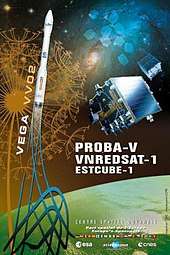Vega flight VV02
Vega flight VV02 was the second flight of the Vega launcher. It occurred from the Guiana Space Centre on 7 May 2013 at 02:06:31 UTC.[1]
 Artwork featured on visitors' brochures | |
| Vega launch | |
|---|---|
| Launch | 7 May 2013, 02:06:31 UTC |
| Operator | Arianespace |
| Pad | Kourou ELV |
| Payload | |
| Outcome | Success |
| Vega launches | |
Payload
The flight was a multi-payload mission that deployed 3 satellites (2 Earth observation satellites and 1 educational CubeSat) into orbit, with a total payload mass of about 638 kilograms (1,407 lb) including the satellites themselves (about 255 kg) and the satellites adapter and dispenser.[1][2]
PROBA-V
PROBA-Vegetation, with a mass of 138.2 kilograms (305 lb), was in the upper position and was the first satellite to be separated, approximately 55 minutes and 27 seconds after liftoff. Its target was a quasi-circular sun-synchronous orbit at an altitude of 820 kilometres (510 mi) and an inclination of 98.73°.[1][3]
VNREDSat-1
VNREDSat-1, with a mass of 115.3 kilograms (254 lb), was in the lower position. Its target orbit was a quasi-circular sun-synchronous orbit at an altitude of 655 kilometres (407 mi) and an inclination of 98.1°, to be deployed 1 hour, 57 minutes and 24 seconds after liftoff.[4]
ESTCube-1
The Estonian Student Satellite-1 (ESTCube-1), with a 1U volume and a mass of 1.33 kilograms (2.9 lb), was the only CubeSat onboard Vega's second flight. It was accommodated in the lower position of the structure, and was deployed by the ISIPOD dispenser 3 minutes and 24 seconds after VNREDSat-1 in approximately the same orbit. It operated for more than 2 years before contact was completely lost on 19 May 2015.[5]
Mission description
Launch date
After being postponed twice[6][7][8][9], the 2nd successful Vega flight took place on 7 May 2013 at 02:06:31 UTC (6 May 2013 at 23:06:31 local time) from the ELV launch pad in Kourou, French Guiana[10][11]. It was the 2nd Arianespace launch of 2013 after Ariane 5 VA212, followed by another 3 Ariane 5 and 2 Soyuz flights.
Orbit
The mission was planned to last 2 hours and 48 seconds, placing its respectively primary and secondary payloads into quasi-circular sun-synchronous orbits at altitudes of respectively 820 kilometres (510 mi) and 665 kilometres (413 mi).[1]
References
- "Vega flight VV02" (PDF) (Press release). Arianespace. 7 May 2013. Retrieved 17 September 2018.
- VV01 to VV04 Missions (PDF) (Report). ASI. 1 April 2015. Retrieved 26 August 2018.
- "PROBA-V". eoPortal Directory. European Space Agency. Retrieved 18 September 2018.
- "VNREDSat-1". eoPortal Directory. European Space Agency. Retrieved 18 September 2018.
- "ESTCube-1". eoPortal Directory. European Space Agency. Retrieved 18 September 2018.
- "Arianespace VV02 – Proba-V, VNREDSat-1 and ESTCube-1: Launch postponed by 24 hours". Arianespace (in French). 25 April 2013. Retrieved 18 September 2018.
- "Arianespace VV02 – Proba-V, VNREDSat-1 et ESTCube-1: Report du lancement de 24 heures" (PDF). Arianespace (Press release). 25 April 2013. Retrieved 18 September 2018.
- "Arianespace Flight VV02 > Vega – Proba-V, VNREDSat-1 and ESTCube-1: Launch postponed". Arianespace (in French). 25 April 2013. Retrieved 18 September 2018.
- "Arianespace Lancement VV02 - Vega – Proba-V, VNREDSat-1 et ESTCube-1: Report du lancement" (PDF). Arianespace (Press release). 3 May 2013. Retrieved 18 September 2018.
- "Second Vega launch by Arianespace a success: Proba-V, VNREDSat-1 and ESTCube-1 in orbit". Arianespace (Press release). 3 May 2013. Retrieved 18 September 2018.
- "Arianespace Lancement VV02 Vega – Proba-V, VNREDSat-1 et ESTCube-1 Succès de la mission" (PDF). Arianespace (in French). 7 May 2013. Retrieved 18 September 2018.
